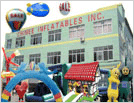
CHINEE,China's Inflatables.
Special Inflatables
Made In Chinee Inflatables Inc.
We offer high quality inflatable products in any size or img, Please browse the inflatable product sorts.
Materials and Production Techniques for Inflatable Products: A Comprehensive Guide
Inflatable products, such as toys, advertising inflatables, and camping gear, rely on high-quality materials and expert production techniques to ensure their durability and safety. In this article, we will explore the different types of materials and production techniques used to create inflatable products, their unique properties, and the advantages and disadvantages of each.
Materials:
The most commonly used materials for inflatable products are PVC (polyvinyl chloride) and polyester fiber. PVC is a synthetic plastic that is known for its durability, flexibility, and resistance to tears and punctures. It is also water-resistant and easy to clean, making it an ideal material for inflatable products that will be used in outdoor or water environments. Polyester fiber, on the other hand, is a lightweight and flexible material that offers excellent resistance to UV rays and is less prone to degradation over time.
Other materials used for inflatable products include nylon, TPU (thermoplastic polyurethane), and vinyl. Nylon is a strong and lightweight material that offers excellent resistance to abrasion and tearing. TPU is a highly elastic and durable material that is known for its excellent resistance to punctures and abrasions. Vinyl is a synthetic plastic that offers excellent resistance to moisture and chemicals.
Production Techniques:
Inflatable products are typically manufactured using two main techniques: heat welding and sewing. Heat welding involves using high-frequency heat to fuse the seams of the material together, creating an airtight seal that prevents air from escaping. This technique is ideal for materials such as PVC, which can be easily fused together using heat.
Sewing, on the other hand, involves stitching the material together to create a seam. This technique is ideal for materials such as nylon and polyester fiber, which may not be compatible with heat welding. Sewing is also useful for creating more intricate designs and patterns on the surface of the inflatable product.
Quality and Safety:
Ensuring the quality and safety of inflatable products requires attention to detail and adherence to established standards and certifications. Inflatable products should be inspected regularly for signs of wear, damage, or degradation. It is also important to ensure that the inflatable product is designed and manufactured to meet safety standards established by organizations such as the American Society for Testing and Materials (ASTM) and the Consumer Product Safety Commission (CPSC).
In summary, inflatable products rely on high-quality materials and expert production techniques to ensure their durability and safety. By understanding the unique properties and advantages of different materials and production techniques, manufacturers can create inflatable products that meet the needs and expectations of their customers. By adhering to established safety and quality standards, manufacturers can ensure that their inflatable products provide a safe and enjoyable experience for users.
Category:Inflatables Knowledge

 About Us
About Us








